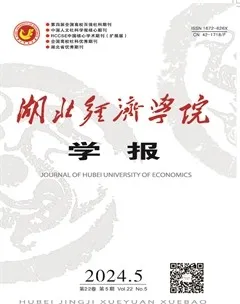部分英文摘要
JOURNAL OF HUBEI UNIVERSITY
OF ECONOMICS
No.5 Sep.15, 2024
Partial Abstract Translation
The Impact of Urban Renewal on High-quality Economic Development
——A Quasi-natural Experiment Based on the Pilot Reconstruction of Old Residential Areas
LI Na-na,GONG Hao ·5·
(School of Economics and Management,Anhui Jianzhu University,Hefei 230000,China)
Abstract: This paper takes the reconstruction of old residential areas as a quasi-natural experiment of urban renewal, selects the data of 110 cities in China from 2011 to 2020 as a sample, and constructs a dual difference model to evaluate the policy impact and function mechanism of urban renewal on the high-quality development of urban economy. The study found that: (1) the implementation of urban renewal policy significantly promotes high-quality economic development and the results are stable through placebo test; (2) urban renewal promotes high-quality economic development mainly by improving consumption level, investment attraction ability and industrial coordination degree; (3) the role of urban renewal on high-quality economic development shows regional heterogeneity, and the implementation of urban renewal policy can significantly promote the improvement of high-quality economic development in eastern region and cities with large population scale, but has no significant impact on central region, western region and urban policies with small population size. The above studies provide new empirical evidence for understanding the relationship between urban renewal and high-quality economic development.
Key words: urban renewal; high4ZG/dqJCsCdMNBJI09VX7g==-quality economic development; reconstruction of old residential areas;double difference method
What Kind of Policy Portfolios of Long-term Mechanism Will Promote the
Stable and Healthy Development of Real Estate Market
——An Empirical Analysis Based on NCA and fsQCA
ZHENG Shi-gang1, ZHENG Yu-lan2 ·19·
(1.School of Economics and Trade, Hubei University of Economics, Wuhan 43025, China;2. Business School, UNSW, Sydney, 2033, Australia)
Abstract: What kind of policy portfolios promotes the stable and healthy development of the real estate market is an important issue on the real estate long-term mechanism. From the central and local government levels, we analyze the policy configurations of the real estate long-term mechanism using NCA and fsQCA methods. Our findings suggest as follows: (1) any single policy and tool of the long-term mechanism does not constitute a necessary condition for the goal of ‘stabilizing house prices, land prices and expectations’; (2) the policy portfolios at the central government level focuses on the logic of stabilization under the dominance of the industry policy, aiming at shaping a stable industrial development environment for the stable and healthy development of the real estate industry; of which, four policy portfolios can achieve housing price stability, including the appraisal target and monetary policy-driven types relying on income distribution and legislation respectively, legislation-driven type, and fiscal and monetary policy-driven type; three policy portfolios can stabilize land prices, including the fiscal and monetary policy-driven type relying on legislation, the appraisal and income-driven type under the logic of reform, and the income-driven type;(3) the policy portfolios at the local government level focus on the logic of structural-led stabilization with obvious structural policy-led logic; among them, four policy portfolios can achieve housing price stability, all of which are fiscal-tax and land system-driven types, respectively, relying on housing system, credit policy, credit policy and housing system, and macro-prudential policy; and five policy portfolios can stabilize land prices, including the fiscal-tax-driven type relying on macro-prudential policy, the credit and fiscal-tax-driven type relying on land supply, the housing system-driven type relying on fiscal-tax and credit policies, and the housing system and taxation-driven types, relying on fiscal-tax, credit and macro-prudential policies, and fiscal-tax, credit and land supply policies, respectively. The research in this paper provides a basis for the central and local governments to further improve the long-term mechanism of real estate, enhance the efficiency of the policy portfolios, and promote the stable and healthy development of the real estate market.
Key words: real estate; long-term mechanism; policy portfolios; fuzzy-set qualitative comparative analysis (fsQCA); necessary conditions analysis (NCA)
The Measurement of Intelligent Logistics Development Level and Its Influencing
Factors in China's Three Major Urban Agglomerations
FU Yi-mang, DONG He-yang ·34·
(School of Economics and Management,Hunan University of Technology, Zhuzhou Hunan 412000,China)
Abstract:As a leading industry in China, the logistics industry is now facing modernization reform. Intelligent logistics with high quality and modern characteristics is becoming the key to promote this reform. Intelligent logistics realizes the refinement, dynamic and visualization of all aspects of logistics through digital intelligence, and improves the efficiency of logistics operation. Based on the entropy weight-TOPSIS model, we measure the comprehensive index of smart logistics development in the Beijing-Tianjin-Hebei, Yangtze River Delta and 2Pearl River Delta urban agglomerations, and establish a Tobit regression analysis model to explore the influencing factors of smart logistics development in urban agglomerations. The research results show that there is a significant spatial difference in the comprehensive index of smart logistics development of the three major urban agglomerations, showing a trend of radiation from south to north, from the central area to the periphery, and the comprehensive index from high to low is the Pearl River Delta, the Yangtze River Delta and Beijing-Tianjin-Hebei. The comprehensive index of smart logistics development in the three major urban agglomerations showed a trend of fluctuating growth in time series, and the agglomeration effect was significant, and the growth rate was from high to low in the Pearl River Delta, Yangtze River Delta and Beijing-Tianjin-Hebei. In addition, further research found that the development of science and technology, government intervention, industrial structure and opening to the outside world have a significant positive impact on the development of smart logistics.
Keywords:intelligent logistics; influencing factors; Tobit model

